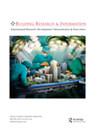高层公寓质量评价及相关人口因素:来自RentSafeTO项目的经验
IF 3.7
3区 工程技术
Q1 CONSTRUCTION & BUILDING TECHNOLOGY
引用次数: 1
摘要
随着城市化的快速发展和高层住宅居民数量的增加,高层住宅的设施、安全、卫生等居住环境质量已成为一个重要的课题。虽然有很多研究通过主观评价来调查居住者的满意度,但很少有研究采用专家评价等客观评价方法来阐述高层公寓的质量和相关的居住者因素。根据多伦多RentSafeTO项目的数据集,该项目使用20个质量指标对9928套高层公寓进行了评估,该研究进行了因子分析,并确定了评估高层住宅的两个主要因素:建筑结构和建筑设施。在此基础上,本文运用多元回归模型和人口普查数据对区域住房质量进行了分析。社会住房和私人住房的结果不同。劳动力属性、教育、移民和种族血统显著影响私人住房的质量。研究结果为高层公寓的使用后评价提供了重要的指导。此外,人口因素对居住质量影响显著。本研究为政府制定平等、公正的高层建筑维修管理支持政策提供了依据。本文章由计算机程序翻译,如有差异,请以英文原文为准。
High-rise apartment quality evaluation and related demographic factors: lesson from RentSafeTO programme
ABSTRACT With the rapid increase in urbanization and the number of residents living in high-rise apartment buildings, the quality of living environments in terms of the facility, safety and hygiene of high-rise housing has become an important topic. Although numerous studies have investigated occupant satisfaction through subjective assessment, only few studies have used objective assessment methods, such as expert evaluation, to elucidate the quality of high-rise apartments and the related occupancy factors. According to the dataset from Toronto's RentSafeTO programme, which provides the results for 9928 high-rise apartments evaluated using 20 quality indicators, this study conducted a factor analysis and identified two main factors for assessing high-rise housing: building structure and building facilities. Furthermore, this study used multiple regression models and census data to analyse the housing quality at the regional level. The results of social housing and private housing differed. Labour force attributes, education, immigration and ethnic origin significantly affected the quality of private housing. The results provide important directions for the post-occupancy evaluation of high-rise apartments. In addition, demographic factors significantly affected residential quality. This study provides a basis for the government to formulate equal and unbiased support for high-rise building maintenance and management.
求助全文
通过发布文献求助,成功后即可免费获取论文全文。
去求助
来源期刊

Building Research and Information
工程技术-结构与建筑技术
CiteScore
8.60
自引率
7.70%
发文量
43
审稿时长
>12 weeks
期刊介绍:
BUILDING RESEARCH & INFORMATION (BRI) is a leading international refereed journal focussed on buildings and their supporting systems. Unique to BRI is a focus on a holistic, transdisciplinary approach to buildings and the complexity of issues involving the built environment with other systems over the course of their life: planning, briefing, design, construction, occupation and use, property exchange and evaluation, maintenance, alteration and end of life. Published articles provide conceptual and evidence-based approaches which reflect the complexity and linkages between cultural, environmental, economic, social, organisational, quality of life, health, well-being, design and engineering of the built environment.
 求助内容:
求助内容: 应助结果提醒方式:
应助结果提醒方式:


